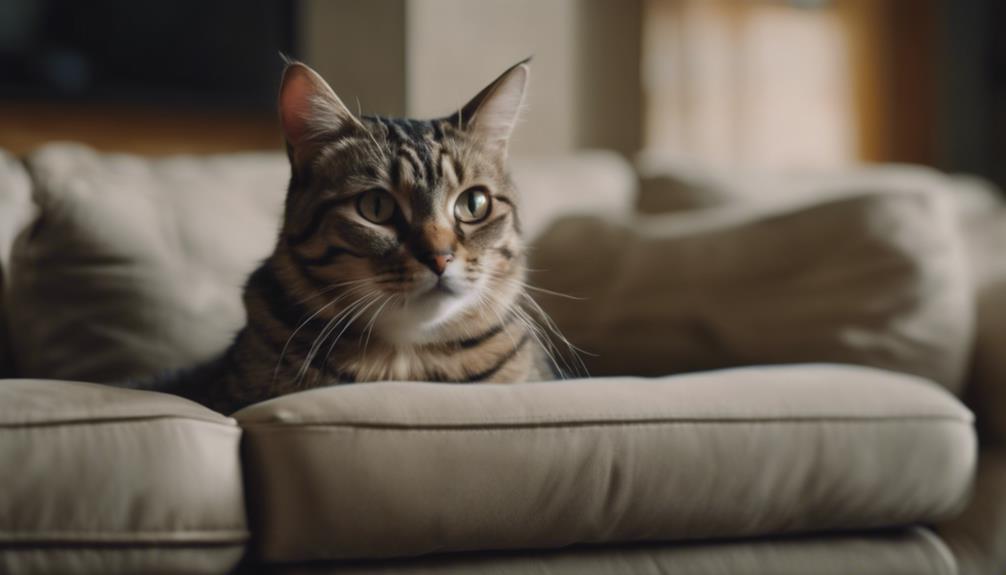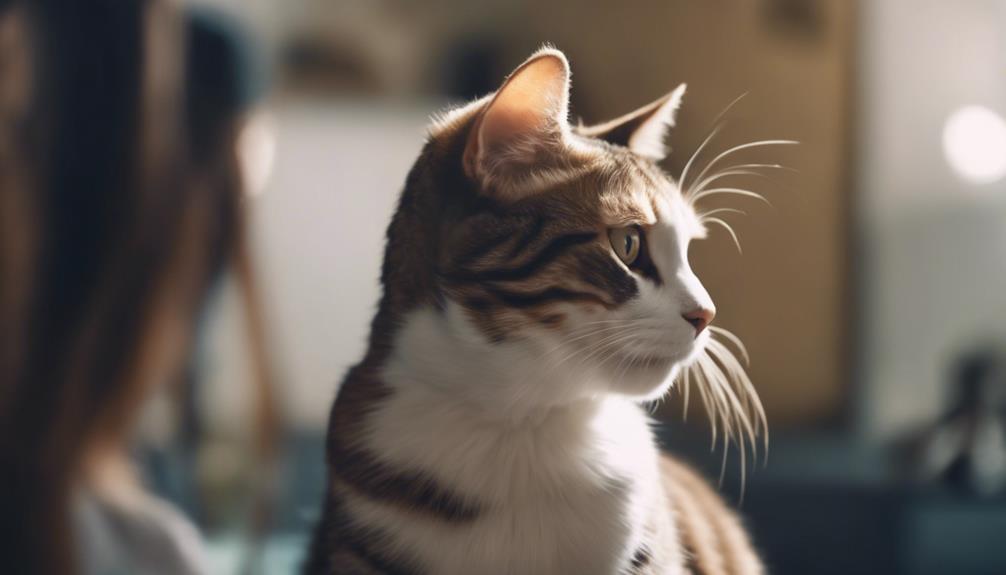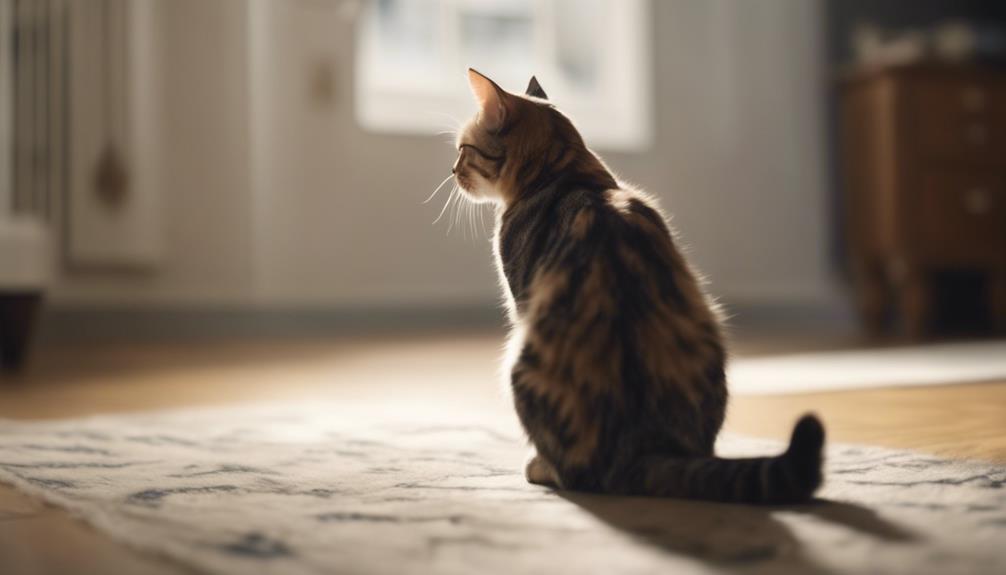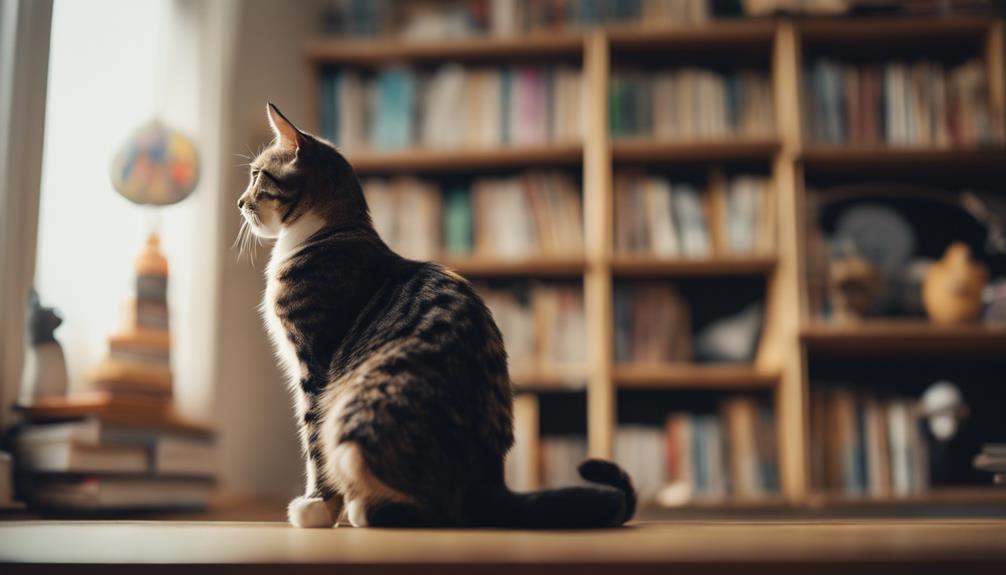Within the realm of feline behavior, one cannot overlook the intriguing phenomenon of cats positioning their hindquarters in proximity to human faces. This seemingly peculiar gesture, often met with a mix of amusement and bewilderment, holds deeper significance in the intricate language of cats.
By unraveling the motives behind this behavior, a window opens to the nuanced world of feline communication and the messages they convey through such actions. Stay tuned as we uncover the enigmatic reasons behind why cats exhibit this behavior, shedding light on the complex layers of cat-human interactions and the unspoken language they share.
Key Takeaways
- Cats view presenting their hindquarters as proper etiquette.
- Cats may seek affection or show trust by putting their butt in your face.
- Understanding cat communication can strengthen the bond with your cat.
- Misinterpreting cat behavior can lead to misunderstandings.
Decoding Cat Communication Etiquette
Deciphering the nuances of cat communication etiquette is essential for fostering a strong and harmonious relationship with your feline companion. Cats have a unique way of expressing themselves, often using behaviors like head butting, rubbing, and yes, even presenting their hindquarters.
While it may seem odd to us, cats view this gesture as a form of proper etiquette. When a cat puts its butt in your face, it can convey various messages such as seeking affection, showing trust, or simply greeting you in a feline manner. Understanding these subtle cues can help prevent misunderstandings and strengthen the bond between you and your cat.
Unveiling Cats' Affectionate Gestures
Understanding cats' affectionate gestures is key to deepening your bond with your feline companion. Cats have unique ways of showing love and trust, and deciphering these behaviors can lead to a more fulfilling relationship.
Here are three common affectionate gestures that cats may display:
- Kneading: When your cat presses their paws gently into you, it's a sign of comfort and contentment.
- Head bunting: Cats show affection by lightly bumping their head against you, marking you with their scent.
- Slow blinking: A slow blink from your cat signifies trust and relaxation, as they feel safe enough to close their eyes in your presence.
Handling Cats' Unusual Behavior With Care

Unveiling the nuances of handling cats' unusual behavior with care requires a keen observation of their unique communication methods and responses. When faced with behaviors like a cat putting its butt in your face, it's crucial to approach the situation with understanding and empathy. Reacting harshly can strain your bond with the feline companion. Instead, gently repositioning the cat and showing affection can convey your acceptance while maintaining boundaries. By respecting their communication style and responding with patience, you can foster trust and strengthen your relationship with your cat.
| Approach | Description | Emotion |
|---|---|---|
| Gentle Repositioning | Avoid startling the cat | Calmness |
| Affectionate Response | Show love and acceptance | Warmth |
| Understanding Signals | Interpret cat's body language | Empathy |
| Patient Communication | Build trust over time | Trust |
| Respectful Boundaries | Acknowledge cat's comfort | Understanding |
Exploring Feline Social Interactions
Exploring the intricacies of feline social interactions sheds light on the nuanced dynamics that shape cats' relationships within their social groups.
- Cats establish hierarchies through body language and vocalizations.
- Mutual grooming is a common behavior that reinforces social bonds among cats.
- Play behavior serves as a way for cats to practice hunting skills and strengthen social connections.
Navigating Cat-Human Bonding Signals

One crucial aspect of fostering a strong bond with your cat involves decoding and responding to their unique communication cues. Cats communicate through various behaviors, including body language, vocalizations, and actions like head butting or presenting their hindquarters. Understanding these signals is key to building a trusting relationship with your feline companion.
When your cat puts their butt in your face, it could be a way of seeking affection, showing trust, or following their natural instincts. By paying attention to your cat's body language and responding with love and patience, you can navigate these bonding signals effectively.
Building a strong bond with your cat requires mutual understanding and respect for each other's ways of communication.
Promoting Positive Cat-Human Relationships
To enhance the bond between cats and humans, fostering positive relationships is essential. Establishing a harmonious connection with your feline companion can lead to a more fulfilling and enriching experience for both parties. Here are three key ways to promote positive cat-human relationships:
- Consistent Positive Reinforcement: Rewarding desirable behaviors with treats or affection can reinforce positive interactions and encourage your cat to engage with you.
- Respect Boundaries: Understanding and respecting your cat's personal space and boundaries can help build trust and mutual respect in the relationship.
- Interactive Playtime: Engaging in interactive play sessions with your cat not only provides mental and physical stimulation but also strengthens the bond between you and your feline friend.
Understanding Cat Body Language Cues

Understanding Cat Body Language Cues plays a crucial role in interpreting your cat's emotions and intentions accurately. Cats use a variety of body language cues to communicate with their owners and other animals. By understanding these cues, you can respond appropriately to your cat's needs and strengthen your bond with them. Here is a table illustrating some common cat body language cues:
| Body Language Cue | Meaning |
|---|---|
| Tail held high | Confidence or happiness |
| Ears flattened | Fear or aggression |
| Purring | Contentment or seeking attention |
Delving Into Feline Trust Signals
Interpreting a cat's body language cues, such as tail position and ear flattening, provides valuable insights into their emotions and intentions, which is particularly crucial when delving into feline trust signals.
- Slow blinking: Cats often slow blink at their owners as a sign of trust and affection.
- Kneading: When a cat kneads you with their paws, it's a display of comfort and trust.
- Rubbing against you: Cats mark their territory by rubbing their scent onto you, showing trust and familiarity.
Resources for Cat Behavior Insights

Exploring various resources on cat behavior can offer valuable insights into understanding and enhancing your feline companion's communication and interactions. Online platforms, such as reputable veterinary websites and cat behavior blogs, provide in-depth articles on interpreting feline behaviors like why cats put their butt in your face.
Books like 'Cat Sense' by John Bradshaw delve into the evolutionary history and psychology behind cat behavior. Seeking advice from certified animal behaviorists or attending cat behavior workshops can also deepen your understanding. Additionally, online forums and communities dedicated to cat owners offer a platform to discuss and learn from others' experiences.
Conclusion
In conclusion, the act of cats putting their hindquarters in close proximity to humans' faces is a complex form of communication rooted in feline behavior. By understanding the nuances of this behavior, one can unravel the intricate messages cats convey and foster stronger bonds with their feline companions.
Remember, when a cat presents its butt to you, it's not just a strange gesture – it's a cat's way of saying, 'I trust you.' 'I trust you enough to show you my vulnerable side and allow you to be a part of my social grooming routine.'




